
A barangay, historically referred to as barrio, is the smallest administrative division in the Philippines and is the native Filipino term for a village, district, or ward. In metropolitan areas, the term often refers to an inner city neighborhood, a suburb, or a suburban neighborhood or even a borough. The word barangay originated from balangay, a type of boat used by a group of Austronesian peoples when they migrated to the Philippines.
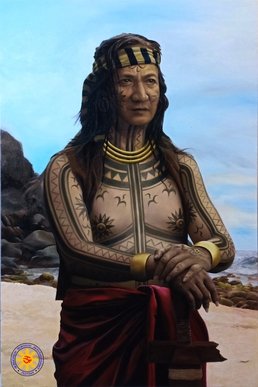
Lapulapu or Lapu-Lapu (ᜎᜉ̰-ᜎᜉ̰), whose name was first recorded as Çilapulapu, was a datu (chief) of Mactan in the Visayas in the Philippines. He is best known for the Battle of Mactan that happened at dawn on April 27, 1521, where he and his warriors defeated the Spanish forces led by Portuguese explorer Ferdinand Magellan and his native allies Rajah Humabon and Datu Zula. Magellan's death ended his voyage of circumnavigation and delayed the Spanish occupation of the islands by over forty years until the expedition of Miguel López de Legazpi in 1564. Legazpi continued the expeditions of Magellan, leading to the colonization of the Philippines for 333 years.
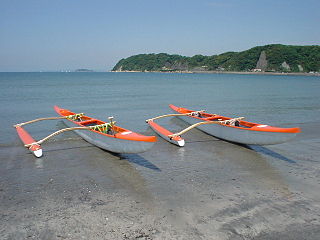
Outrigger boats are various watercraft featuring one or more lateral support floats known as outriggers, which are fastened to one or both sides of the main hull. They can range from small dugout canoes to large plank-built vessels. Outrigger boats can also vary in their configuration, from the ancestral double-hull configuration (catamarans), to single-outrigger vessels prevalent in the Pacific Islands and Madagascar, to the double-outrigger vessels (trimarans) prevalent in Island Southeast Asia. They are traditionally fitted with Austronesian sails, like the crab claw sails and tanja sails, but in modern times are often fitted with petrol engines.

The Philippine Navy (PN) is the naval warfare service branch of the Armed Forces of the Philippines. It has an estimated strength of 24,500 active service personnel, including the 8,300-strong Philippine Marine Corps. It operates 82 combat vessels, 14 auxiliary vessels, 25 manned aircraft and 8 unmanned aerial vehicles. It shares the responsibility of patrolling the maritime borders with the Philippine Coast Guard, a formerly attached unit which became a separate maritime law enforcement agency in 1998.

The vinta is a traditional outrigger boat from the Philippine island of Mindanao. The boats are made by Sama-Bajau, Tausug and Yakan peoples living in the Sulu Archipelago, Zamboanga peninsula, and southern Mindanao. Vinta are characterized by their colorful rectangular lug sails (bukay) and bifurcated prows and sterns, which resemble the gaping mouth of a crocodile. Vinta are used as fishing vessels, cargo ships, and houseboats. Smaller undecorated versions of the vinta used for fishing are known as tondaan.

A kora-kora or kora kora or coracora is a traditional canoe from the Maluku (Moluccas) Islands, Indonesia. They are naval boat for carrying men on raids for plunder or for slaves. In Maritime Southeast Asia, raiding for slaves was an honourable way of making a living, and the kora kora was needed for defence against raids as well as for forays. Large kora-kora is called juanga or joanga.

Paraw are various double outrigger sail boats in the Philippines. It is a general term and thus can refer to a range of ship types, from small fishing canoes to large merchant lashed-lug plank boats with two outriggers (katig) propelled by sails

In early Philippine history, Barangay is the term historically used by scholars to describe the complex sociopolitical units which were the dominant organizational pattern among the various peoples of the Philippine archipelago in the period immediately before the arrival of European colonizers.
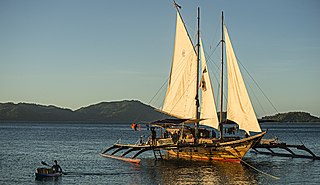
A Balangay, or barangay is a type of lashed-lug boat built by joining planks edge-to-edge using pins, dowels, and fiber lashings. They are found throughout the Philippines and were used largely as trading ships up until the colonial era. The oldest known balangay are the Butuan boats, which have been carbon-dated to 320 AD and were recovered from several sites in Butuan, Agusan del Norte.
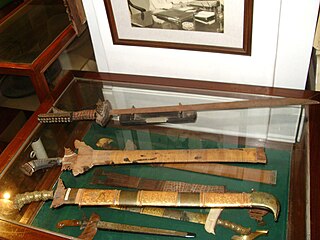
Warfare in pre-colonial Philippines refers to the military history of the Philippines prior to Spanish colonization.

Karakoa were large outrigger warships from the Philippines. They were used by native Filipinos, notably the Kapampangans and the Visayans, during seasonal sea raids. Karakoa were distinct from other traditional Philippine sailing vessels in that they were equipped with platforms for transporting warriors and for fighting at sea. During peacetime, they were also used as trading ships. Large karakoa, which could carry hundreds of rowers and warriors, were known as joangas by the Spanish.

Lanong were large outrigger warships used by the Iranun and the Banguingui people of the Philippines. They could reach up to 30 m (98 ft) in length and had two biped shear masts which doubled as boarding ladders. They also had one to three banks of oars rowed by galley slaves. They were specialized for naval battles. They were prominently used for piracy and slave raids from the mid-18th century to the early 19th century in most of Southeast Asia. The name lanong is derived from Lanun, an exonym of the Iranun people.
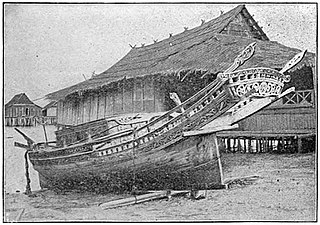
Lepa, also known as lipa or lepa-lepa, are indigenous ships of the Sama-Bajau people in the Philippines and Malaysia. They were traditionally used as houseboats by the seagoing Sama Dilaut. Since most Sama have abandoned exclusive sea-living, modern lepa are instead used as fishing boats and cargo vessels.

Bangka are various native watercraft of the Philippines. It originally referred to small double-outrigger dugout canoes used in rivers and shallow coastal waters, but since the 18th century, it has expanded to include larger lashed-lug ships, with or without outriggers. Though the term used is the same throughout the Philippines, "bangka" can refer to a very diverse range of boats specific to different regions. Bangka was also spelled as banca, panca, or panga in Spanish. It is also known archaically as sakayan.

Guilalo, were large native sailing outrigger ships of the Tagalog people in the Philippines. They were common vessels in Manila Bay in the 18th and 19th centuries. They were easily identifiable by their two large settee sails made with woven fiber. They were steered by a central rudder and can be rowed with round-bladed oars.

Cascos are flat-bottomed square-ended barges from the Philippines. They were used mostly to carry cargo along lakes and rivers, and as lighters to transport goods to and from moored ships. Though they resemble the Chinese sampan, they are much larger with two detachable masts with junk rigs made of woven fiber. They also possess outrigger-like platforms along the entire length of the sides, which is used by punters with barge poles when traversing shallow water. They were steered by an oar or a central rudder by a helmsman housed in a small raised platform at the stern. The entire deck is covered almost entirely in removable curving or pitched panels.

Salambáw, is a type of lift net used by indigenous fishermen in the Philippines. They are found throughout the Philippine islands but are most prevalent in large lakes like Laguna de Bay, and sheltered coastal areas like the Manila Bay, Ragay Gulf, and Batan Bay. Variations of salambáw lift nets include the bintol, panak, tangkal, and the basnig. Salambáw rafts were also known as saraboa or salakab.

A juanga or joanga refers to large-sized kora-kora, karakoa and lanong. They are used all throughout the Philippines and Eastern Indonesia, in Maluku smaller versions were popular and are still used to this day (Kora-kora). They are propelled by oars but are not used for carrying cargo.

Daramba is a Visayan term referring to paddling and fighting platforms mounted directly on the outriggers (katig) of traditional large trimaran warships (balangay) of the Philippines. They accommodated one or more rows on each side of commoner warriors (horo-han) with large leaf-shaped paddles (bugsay) during travel, naval warfare, and seasonal coastal raids (mangayaw). The paddlers were kept in rhythm by various chants and songs. The platforms for the horo-han are distinguished from the side-mounted fighting platforms (pagguray) of the warrior-nobility, which were also built on the outriggers, in that the daramba is mounted on or near the water surface, while the pagguray is mounted above, closer to the hull.
























